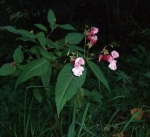Himalayan Balsam and Happy Valley


By markle
- 983 reads
“Verde, que te quiero, verde” – Federico Garcia Lorca
An alien landscape at the path’s edge. I was just at the start of a downward slope between trees, pleased with dry earth underfoot instead of the usual mud. I stopped, with something like shock. Himalayan balsam filled all the space between the trunks.
Its leaves are long, serrated like delicate flint knife blades. Its flowers are almost orchid shaped, pale pink or white, and give off an overripe sweetness.
If I looked up I saw the late summer light filtering through the leaves of oaks and ash trees, a familiar sight on this part of the walk up to Boars Hill from south Oxford. Down – the balsam, and nothing else. It was an everyday version of the moment in a Wyndham novel or an old sci fi film when the hero suddenly realises “something is terribly wrong”.
The balsam plants are not triffids – the real-life equivalent of those vegetable monsters would probably be Japanese knotweed – but in this patch of wood and many others around Oxford, near my parents’ house in Staffordshire, and all over the UK, they are establishing a monoculture as ruthless as in any pesticide-drenched, hyper-fertilised wheat field.
I don’t want to get sentimental about the displaced flora. This walk up Hinskey Hill is one of my favourites, but an honest account would not report much variety in the path verges. Ferns, brambles, grass, nettles and a few straggles of other flowers are all there is for the most part. Most more specialised species have long been driven out by the impact of modern agriculture. But to see even that resilient group completely obliterated by crowds of just one species was unsettling.
The spread of the balsam in recent years has been swift, and I began to wonder how long it would take before the first shoots began appearing in Happy Valley (more officially, Chilswell Valley Nature Reserve), the one major exception on this walk to the “bracken and brambles” routine.
The path to Happy Valley from the city lies over the A34 and along the side of a field where unexpectedly the grass is long and flowers show between the seedheads. Butterflies rise up: holly blue, meadow brown, peacocks, whites. On a hot day when the green is all but bleached out, this stretch can be a sweaty climb. At the top of the hill there’s a never-failing apple tree and a view across all of Oxford – college, hospitals, industry, housing – and its rural surrounds. There’s also the gate that leads into the path along the valley top.
The city council owns the nature reserve. Another path runs down by the stream along the middle, through reedbeds and woodland. But the path along the top is my favourite.
I walked it first with my wife at about the same time of year as my encounter with the Himalayan balsam – late August. On one side a long row trees separates the mown path from the golf course on the other side. Some parts are filled with generous sloe bushes, and I see groups of goldfinches here all year round. On the other side the ground drops steeply into the V of the valley. In August the grasses are in full seed and flowers are peaking, including knapweed, which is my favourite for reasons I don’t really understand. More butterflies. It’s so rich in comparison with an ordinary, “improved” field of grass that even an inveterate strider-out like me feels the need to dawdle.
Between the end of the valley and the first clumps of balsam are some paddocks and a cattle field, and between them, Chilswell Farm. In some ways the farm epitomises the way in which this part of the countryside is changing. Once a working farm, it was undergoing conversion into the plush apartments that now occupy its buildings when we first saw it. On the other side of the track stands a great grey barn thrown up a few years ago, surrounded by large quantities of farm equipment.
Further back in its history (dubious sources inform me) it may have been the site of a battle for the rich lands of the Thames Valley between two early Saxon war bands. It may also have been the site of a daughter chapel of Abingdon Abbey, or even the site where the original abbey was founded, before it was moved to the settlement at Abingdon (according to equally dubious sources). I like these tall tales, but the swallows above the farm pond are the chief attraction for me.
The farm is visible from the first clumps of balsam on the path. It’s only a few hundred metres from those clumps to the start of the Happy Valley. If, when, it makes the leap, will anyone be prepared to push it back out of the nature reserve? Unlike Japanese knotweed, Himalayan balsam can be eradicated, but of course at a cost. So far there is enough space left between clumps that the cost of removing it seems too high. But as it spreads and spreads, and more areas turn into its monoculture, the monetary cost of removing it will keep rising – and so perhaps it will push on and on. At what point does the cost of vanished species – even scrubby ones like those that used to grow among the trees further up the path – start to outweigh the monetary cost of action?
As in a John Wyndham novel, the problem began with a human action – one without malice, apparently innocent. Himalayan balsam was introduced as an exotic garden plant, and it’s easy to see why. As the leaves in the wood shifted in the breeze, they gave gentle colour to the reflected sunlight, and the flowers soothed the eye with their softness. A few days later I saw someone collecting a bouquet of its flowers from a stand of plants near the Thames. But the garden plant, like Japanese knotweed, like Tree of Heaven, like the grey squirrel, like the signal crayfish, like the American mink, and many others, outgrew its original foothold, and now outcompetes everything it encounters.
Many times I’ve written of change in the countryside as something to be accepted, that it is inherent in the rural as much as the urban. So it may seem contradictory to bemoan it. But some change can be adapted to – other kinds seem to destroy without recompense. If Himalayan invades and occupies Happy Valley, I believe that something immensely valuable will have been lost.
These glum musings followed me through the rest of my walk, darkening the background even while I drift along the contours of “Matthew Arnold’s field” (“improved” for grazing) and enjoyed the view over the plan west of the city from the far side of the hill (mostly intensive arable land). Maybe I will get used to Himalayan balsam. It seems certain that I can’t love this countryside as much as I do without some element of doublethink.
- Log in to post comments
Comments
Interesting to read your
Interesting to read your musings and your ramblings. Each part of the country can be so different, and at each day, season. Glad there is so much to enjoy, despite the Balsam worries. My sister mentioned recently I think that when she was young she and her friend were making a wildflower collection, and the friend's father brought back from some outing a 'new' plant - Himalayan Balsam! Rhiannon
- Log in to post comments


